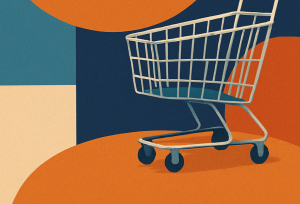
Share
While there are certainly many negative macro economic implications from the Coronavirus, such as major festivals and events cancelling, dips in the stock market, impact on global travel, and more a subtle silver lining amidst all of this disheartening news is that the e-commerce industry is actually seeing a slight bump.
Why? Well, the justifiable fear of COVID-19 (the medical term for Coronavirus) has people self-quarantining (“cocooning”) and stocking up on essential items. Shopping in general is being done online to a much greater extent, and less people are risking it by heading out to crowded stores to buy their goods.
In other words, now is not the time to bail on your e-commerce strategies. Rather, the goal should be to analyze and prepare for a new form of managing supply-chain logistics in order to outsmart this tragic and deadly disease.
Our VP of Finance, Jonathan Moisan, is not so sure the mass panic around Coronavirus is based in anything other than fear and speculation:
Jonathan says, “I believe a lot of the uncertainty right now with the stock market is based off of fear and not actual implications of the economy. Just last week it was published that unemployment is at 3.5% which is the lowest it’s been in 50 years (An indicator of economic health). Consumer behavior and spending habits have not changed and we are seeing the data to support that with our clients.”
Chinese retail giant, JD.com said an increasing number of consumers are buying their daily products online. In fact, from Jan. 24 to Feb. 2, its sales of rice and flour increased 5 times.
Of course, supply chain and shipping logistics have become much more difficult to manage. Enter cloud stores. Through them, shop assistants can share and sell products online, helping offline stores reduce losses. Consumers are also encouraged to share their favorite products with friends to earn commissions. JD said sales reached nearly RMB 10 million ($1.4 million) in the first seven days.
We’re likely to see similar innovative measures taken in the United States and decreases in in-store sales while online delivery logistics are sorted out and demand is met with a kind of remote supply chain that can help people get the items they need without stepping outside of their homes.
The fear of contamination and a potential pandemic is very real. That’s why I’m hesitant to celebrate this news. However, it’s important to highlight the fact that we’re lucky to have an infrastructure that allows for people to continue buying things they need without having to leave the safety of their homes. This is all thanks to the digital sales environment.
That being said, I don’t want to minimize this. The disease of course is serious and in some cases deadly. At the time of writing this, 108,000 cases of infection have been found around the world and 3,800 people have perished because of it. Those percentages aren’t high if you consider there are 7.53 billion of us on earth, but you can never be too careful.
With coronavirus cases increasing in the U.S., some product shortages have already become evident. For example, many pharmacies across the world, including those in the U.S., are sold out of hand sanitizers. This will prompt shoppers to search online for the products, again changing the shopping behavior of some customers who have never bought these types of products online.
The same issue is arising with items such as toilet paper, non-perishable food goods, medicine, and other items perceived to be necessary if things were to escalate.
Experts have weighed in on this e-commerce bump:
“Medium term, we believe ‘cocooning’ could actually boost e-commerce growth rates, while online marketplaces should be somewhat less impacted than online retailers or DTC brands due to their diversity of suppliers and/or seller base,” said Robert W. Baird analyst Colin Sebastian in a research note. “At this point, we believe negative Q1 guidance revisions are possible or even likely across our coverage as companies attempt to quantify the near-term headwinds from the COVID-19 outbreak.”
Again, this is nothing to celebrate, but it should at the very least alleviate concerns that online brands may have during this uncertain and troubling time.
Sebastian added that the coronavirus-driven cocooning effect here in the U.S. is a “theoretical” concept. We’re merely extrapolating from what we saw in China, where sales of fresh food on JD.com jumped 215% in the 10-day period ending Feb. 2, according to Digiday.
So, yes, this trend exists of “cocooning” and looking to online and delivery channels to order goods, but I’d also add or argue that the goods that might begin to fly off the shelves are for the most part these kinds of necessary or emergency-based goods.
Of course, we always look at things from the lens of an American business, but we do work with companies whose supply chains are based in Asia. Things in the Far East are much more dire and therefore the effects have been more drastic.
As the coronavirus continues to spread, China’s status as the epicenter of major supply chains is causing significant changes to businesses and consumer behavior. This is not only putting a strain on multiple industries within the country, but multinationals operating out of and doing business in China are feeling the effects as well.
Consumer demand isn’t going to lessen. If anything, it will increase. That’s why e-commerce ends up being the saving grace, in many ways here.
That being said, there have certainly been major hiccups in delivery operations.
Both UPS and FedEx warned of shipment disruption and delays in countries most affected by the COVID-19 outbreak, according to Reuters.
“We are taking recommended precautions in terms of pilot, team member and customer health and safety,” FedEx told Reuters, adding it is flying in and out of affected countries but travel restrictions are affecting transit times.
“In the affected areas, we continue to support demand where it exists from our customers, and we are prepared to resume normal operations in mainland China and Northern Italy as soon as government restrictions are lifted and regular commercial demand returns,” said UPS spokesman Matthew O’Connor. “In China, we are at almost 100% of normal staffing and demand is rapidly resuming as commercial activity returns to normal.”
Certain categories of products have seen the biggest bump, again including health and personal care, sports and outdoors, and baby products. Some smaller sub-categories within these verticals have seen 90% growth rates as customers make larger purchases.
So yes, I want to reiterate, this is by no means time to celebrate. Even with a bump in sales, if scientists don’t develop a vaccine quickly enough or if we don’t see positive results and less cases of COVID-19, who knows what will happen.
However, we’re here to report that the very least you could do is to ride this thing out. Continue optimizing your affiliate strategy and you shouldn’t see a major hit. Stay safe out there and good luck!



